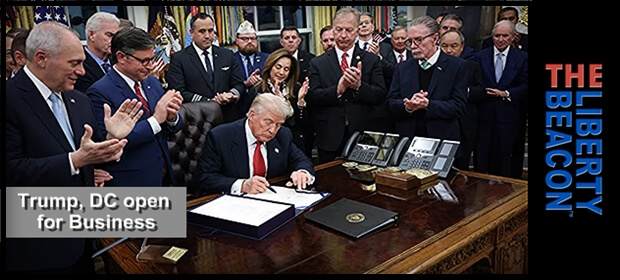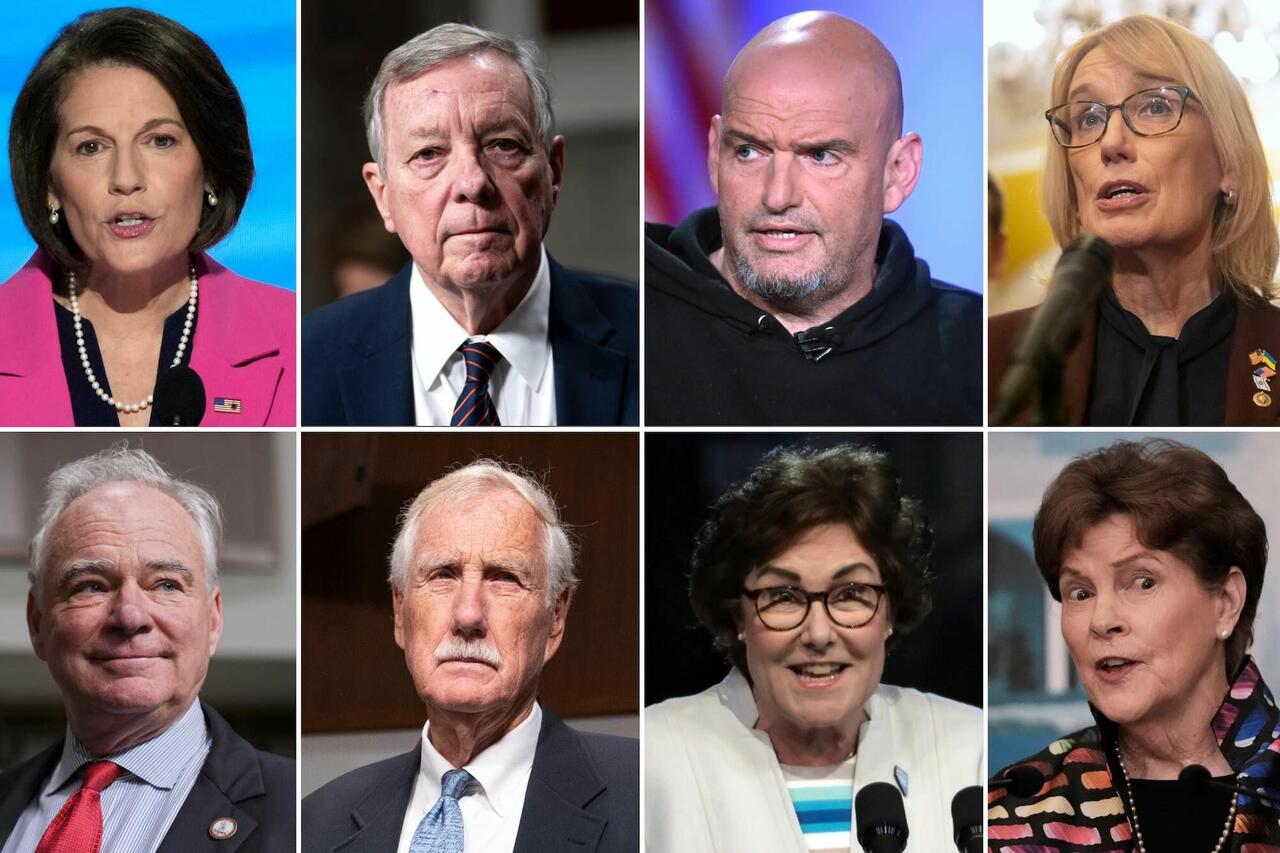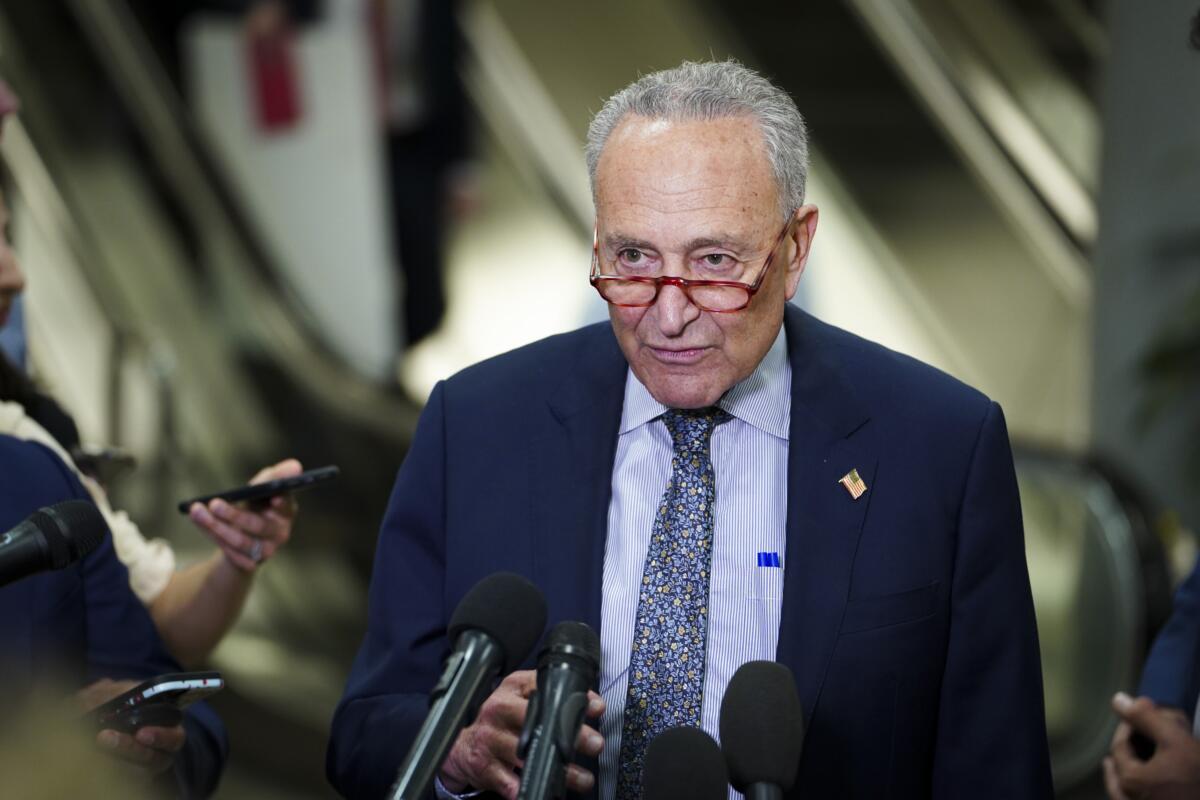
How Centrists Broke Ranks To End Shutdown As Democratic Rift Widens
A Quiet Meeting, a Major Shift
(Tyler Durden Reports) – The political breakthrough that ended the longest government shutdown in U.S. history did not come from the Oval Office or from the Senate’s top Democrat. Instead, it emerged from a quiet, late-night meeting in a nearly deserted Capitol, where a small band of centrist Democrats forged an agreement with senior Republicans – over the objections of their own leadership.
 Moderate Democrat senators who cut deal to end the government shutdown: Sen. Catherine Cortez Masto, D-Nev., top row from left, Senate Judiciary Committee Chairman Dick Durbin, D-Ill., Sen. John Fetterman, D-Pa., Sen. Maggie Hassan, D-N.H., and bottom row from left, Sen. Tim Kaine, D-Va., Sen. Angus King, I-Maine, Sen. Jacky Rosen, D-Nev., and Sen. Jeanne Shaheen, D-N.H. AP Photo
Moderate Democrat senators who cut deal to end the government shutdown: Sen. Catherine Cortez Masto, D-Nev., top row from left, Senate Judiciary Committee Chairman Dick Durbin, D-Ill., Sen. John Fetterman, D-Pa., Sen. Maggie Hassan, D-N.H., and bottom row from left, Sen. Tim Kaine, D-Va., Sen. Angus King, I-Maine, Sen. Jacky Rosen, D-Nev., and Sen. Jeanne Shaheen, D-N.H. AP Photo
A Quiet Meeting, a Major Shift
According to the Wall Street Journal, two nights before Halloween, with federal workers missing paychecks and food-assistance programs running dry, Sens. Angus King of Maine, Jeanne Shaheen and Maggie Hassan of New Hampshire – each a former governor, slipped into Senate Majority Leader John Thune’s office after the chamber had adjourned. Joining Thune were Republican Sens. John Hoeven of North Dakota, also a former governor and veteran appropriator, and Susan Collins of Maine, along with Sen. Katie Britt of Alabama.
The group had grown impatient. Nearly a month into the shutdown, they saw little sign that President Trump or Senate Minority Leader Chuck Schumer would break the stalemate. “It was a group of people trying to solve a problem,” Mr. King said.
When asked by MSNBC why he caved, King said that trying to “stand up to Donald Trump” simply didn’t work…
Sen Angus King explains that the Democrat shutdown strategy of “standing up to Donald Trump” didn’t work.
This is sure to play well with the enraged base. pic.twitter.com/thSes5tE8U
— Western Lensman (@WesternLensman) November 10, 2025
Schumer was informed of the dialogues, lawmakers said, but declined to participate. The Democratic leader believed time was on his side: that Trump would eventually feel compelled to negotiate and Democrats could secure a more favorable outcome – including an extension of expiring Affordable Care Act subsidies that had become the central Democratic demand.
The centrists, however, saw a riskier path. And with little progress from the White House, they proceeded.
A Deal That Divides
The negotiations produced a bipartisan agreement to reopen most of the government through Jan. 30 and fully fund several key programs, including food assistance, for a year. Thune pledged a December vote on extending the ACA subsidies, though he would promise no outcome.
To the centrists, the commitment – combined with the January funding deadline, which gives Democrats an opportunity to force another showdown – was enough. “We sat across from him, we looked him eye to eye,” Ms. Shaheen said, describing her trust in Thune’s assurances.
For many Democrats, it was not. Progressives and party activists erupted in anger, accusing the centrists of caving with little to show for it. Schumer, who voted against the measure, faced criticism from both sides: progressives for failing to keep the caucus unified, and centrists for resisting what many viewed as the only viable off-ramp.
Schumer’s allies counter that he held his caucus together longer than Republicans expected and that Democrats had successfully elevated healthcare costs as the defining issue heading into the midterms.
Internal Pressure Mounts
Centrists briefed Schumer regularly and agreed to his requests to delay any commitments until after Nov. 1, the start of Obamacare open enrollment, and then until after the Nov. 4 election. But as new Democratic electoral victories rolled in, many senators still preferred to hold firm.
That position became harder to justify as the shutdown’s effects escalated. Flight delays worsened. Federal workers missed multiple paychecks. Food-assistance and heating-aid benefits dwindled.
By Sunday, eight Democrats had peeled off, concluding that Trump would not enter negotiations anytime soon. “We were harming a lot of people in the service of a strategy that wasn’t working,” King said.
A Last-Minute Push
Schumer made his final bid on Friday: reopen the government in exchange for a one-year extension of the ACA subsidies. Republicans swiftly rejected it. Over the weekend, centrists renewed their push, bolstered by growing Democratic defections.
On Sunday, Schumer said he could not support a deal “that fails to address the healthcare crisis.” But the votes were slipping away. Republicans needed the support of Sen. Tim Kaine of Virginia to secure the necessary 60 votes. Britt, alongside GOP leadership and White House officials, worked with Kaine to add provisions reversing shutdown-driven federal layoffs and prohibiting new ones through January.
Kaine agreed. Late Sunday, the Senate advanced the measure 60–40, with no votes to spare.
Political Fallout
For Schumer, the episode marks another intraparty challenge. In March, he was criticized for voting with Republicans to avert a shutdown; now he is under fire for failing to maintain one. Still, Democrats credit him with elevating healthcare as a defining issue for the coming midterms.
On Monday, he framed the outcome as a Republican miscalculation. “Republicans now own this healthcare crisis,” he said. “They knew it was coming. We wanted to fix it. Republicans said no.”
Whether voters will see it that way – or whether the schism between Democratic factions widens – remains an open question. What is clear is that, in the end, it was the quiet work of centrists—not high-level brinkmanship—that forced the government back open.
On Tuesday Sen. John Fetterman (D-PA) appeared on Fox News to tell the world that “no one really knows” who’s in charge of Democrats on Capitol Hill – as Schumer “never” discussed the shutdown with him.
Fetterman addressed an Axios report that confirms the above: Schumer privately pressured a group of moderate Democrats in mid-October to keep the government closed until Obamacare open enrollment on Nov. 1.
When asked by co-host Lawrence Jones “Who is running the show now in the Democratic Party, in the Senate, in the House?” Fetterman replied: “No one really knows.”
“It’s always a hard yes to keep our government open,” Fetterman explained. “I mean, that’s my principle, because it’s wrong to shut our government down. And now we knew that we would put [at risk] those 42 million Americans for SNAP and paying our military and, you know, the Capitol Police. I mean, people have went five weeks without being paid. I mean, that’s a violation of my core values. And I think it’s [a violation of] our party’s [values] as well.“
___________
Header featured image (edited) credit: CNN News screen grab. Emphasis added by (TLB)
••••
••••
Stay tuned…
![]()
••••
The Liberty Beacon Project is now expanding at a near exponential rate, and for this we are grateful and excited! But we must also be practical. For 7 years we have not asked for any donations, and have built this project with our own funds as we grew. We are now experiencing ever increasing growing pains due to the large number of websites and projects we represent. So we have just installed donation buttons on our websites and ask that you consider this when you visit them. Nothing is too small. We thank you for all your support and your considerations … (TLB)
••••
Comment Policy: As a privately owned web site, we reserve the right to remove comments that contain spam, advertising, vulgarity, threats of violence, racism, or personal/abusive attacks on other users. This also applies to trolling, the use of more than one alias, or just intentional mischief. Enforcement of this policy is at the discretion of this websites administrators. Repeat offenders may be blocked or permanently banned without prior warning.
••••
Disclaimer: TLB websites contain copyrighted material the use of which has not always been specifically authorized by the copyright owner. We are making such material available to our readers under the provisions of “fair use” in an effort to advance a better understanding of political, health, economic and social issues. The material on this site is distributed without profit to those who have expressed a prior interest in receiving it for research and educational purposes. If you wish to use copyrighted material for purposes other than “fair use” you must request permission from the copyright owner.
••••
Disclaimer: The information and opinions shared are for informational purposes only including, but not limited to, text, graphics, images and other material are not intended as medical advice or instruction. Nothing mentioned is intended to be a substitute for professional medical advice, diagnosis or treatment.


Leave a Reply